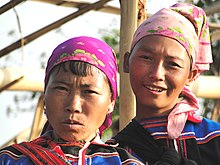 Two Wa women in traditional clothing | |
| Total population | |
|---|---|
| approx. 1.2 million | |
| Regions with significant populations | |
| 800,000 | |
| 400,000 | |
| 10,000 | |
| Languages | |
| Wa Secondary languages: | |
| Religion | |
| Animism Buddhism[1] Christianity | |

The Wa people (Wa: Vāx; Burmese: ဝလူမျိုး, [wa̰ lùmjóʊ]; Chinese: 佤族; pinyin: Wǎzú; Thai: ว้า) are a Southeast Asian ethnic group that lives mainly in Northern Myanmar, in the northern part of Shan State and the eastern part of Kachin State, near and along Myanmar's border with China, as well as in China's Yunnan Province.
Historically, the Wa have inhabited the Wa States, a territory that they have claimed as their ancestral land since time immemorial.[2] It is a rugged, mountainous area located between the Mekong and the Salween River, with the Nam Hka flowing across it. The Wa traditionally practiced subsistence agriculture by cultivating rice, peas, beans, poppies and walnuts. They bred water buffaloes, which they used mainly for sacrificial purposes.[3] Generally, the traditional customs of the Wa, as well as their lifestyle, are very similar to those of the Naga people further to the Northwest.[4] The Wa people speak the Wa language which is part of the Mon-Khmer group of languages.
Many of the Wa are animists and a small proportion of the population follows a derivative of either Buddhism or Christianity.
- ^ [1] Archived 2013-06-27 at the Wayback Machine, [2] Archived 2015-09-23 at the Wayback Machine Ethnic Groups - china.org.cn
- ^ Fiskesjö, Magnus (15 June 2010). "Mining, history, and the anti-state Wa: the politics of autonomy between Burma and China". Journal of Global History. 5 (2): 241–243. doi:10.1017/S1740022810000070 – via Cambridge University Press Journals Complete.
- ^ The Imperial gazetteer of India
- ^ "M. Fiskesjo, On the Ethnoarchaeology of Fortified Settlements in the Northern part of Mainland Southeast Asia" (PDF). Archived (PDF) from the original on 2014-10-14. Retrieved 2014-10-10.